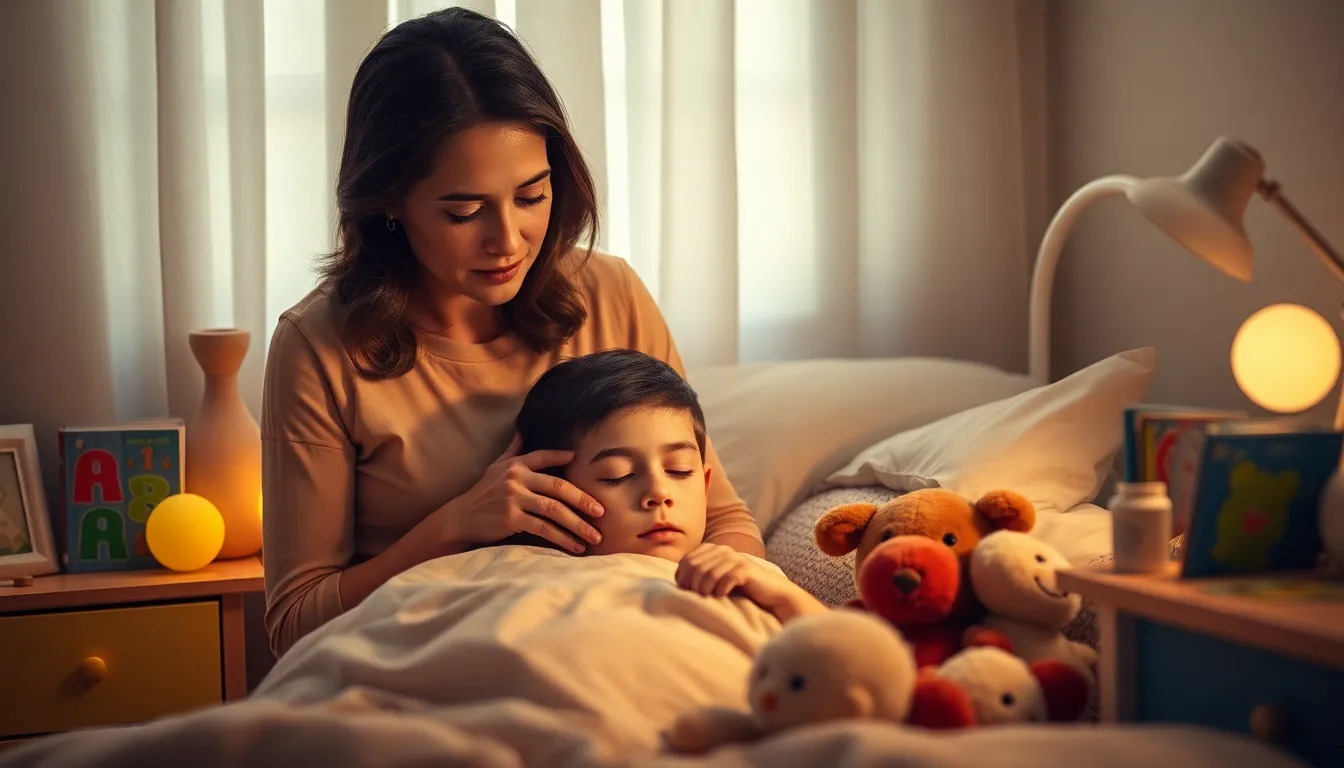When the sun goes down and the stars come out, most kids are dreaming of candy castles and superhero adventures. But for some, sleep is as elusive as a unicorn at a birthday party. Child insomnia isn’t just a parent’s headache; it’s a nightly mystery that leaves everyone wide awake and wondering what went wrong.
Table of Contents
ToggleUnderstanding Child Insomnia
Child insomnia involves difficulties with falling asleep or staying asleep, which hampers a child’s overall well-being. This issue can disrupt daily activities and affect emotional health.
Definition of Child Insomnia
Child insomnia refers to chronic sleep disturbances in children, characterized by trouble initiating or maintaining sleep. Symptoms may include difficulty settling down at bedtime and frequent waking at night. Children experiencing insomnia might exhibit signs of fatigue and irritability during the day. Effective identification requires parents to observe consistent sleep patterns that deviate from typical behavior.
Prevalence and Statistics
Data suggests that approximately 20% of children encounter insomnia at some point in their childhood. Research indicates that insomnia rates are notably higher among adolescents, reaching up to 30%. Factors contributing to these statistics include anxiety, stress, and poor sleep hygiene. Understanding the prevalence assists in recognizing how widespread this issue is among families. Pediatricians often emphasize the importance of addressing sleep problems early to minimize long-term impacts on health.
Causes of Child Insomnia

Child insomnia can stem from various causes, influencing sleep patterns and overall well-being. Understanding these causes helps in addressing sleeplessness effectively.
Biological Factors
Genetic predisposition plays a role in child insomnia, with some families more prone to sleep issues. Hormonal changes, particularly during puberty, can disrupt sleep cycles. Medical conditions like asthma, allergies, and chronic pain can also interfere with a child’s ability to fall or stay asleep. Neurodevelopmental disorders, such as ADHD, are frequently linked to sleep disturbances, making it difficult for children to regulate their sleep effectively. Age also impacts sleep needs and patterns, with younger children often requiring more sleep than older kids.
Psychological Factors
Anxiety often triggers insomnia in children, manifesting through worries about school or social situations. Stress from family dynamics, such as divorce or relocation, can create an environment unfriendly to restful sleep. Depression is another factor, commonly leading to fatigue and restlessness. Children may internalize feelings of pressure from academic demands, resulting in sleepless nights. Additionally, the impact of trauma can linger, disrupting sleep and emotions significantly.
Environmental Factors
A child’s sleep environment significantly influences sleep quality. Noise from traffic or household activities can lead to frequent nighttime awakenings. Inadequate lighting may also prevent a child from settling down comfortably. The presence of screens in bedrooms has been linked to difficulties in initiating sleep due to blue light exposure. Poor sleep hygiene practices, such as irregular sleep schedules or stimulating activities before bedtime, further exacerbate insomnia. Climate conditions, including room temperature and humidity, can also affect a child’s ability to sleep soundly.
Symptoms of Child Insomnia
Child insomnia manifests through various symptoms, helping caregivers identify sleep disturbances early.
Behavioral Signs
Irritability often marks the child’s behavior during the day. Difficulty concentrating at school provides further evidence of sleep issues. Frequent mood swings can indicate underlying sleep problems. Children may resist bedtime routines or exhibit hyperactivity just before sleep. Clinginess during the day sometimes occurs due to nighttime fears. Increased anxiety about sleeping alone may surface as a behavioral response. Nightmares or night terrors frequently lead to reluctance to sleep. Loss of interest in daily activities might also stem from inadequate rest.
Physical Signs
Fatigue emerges as a primary physical symptom of insomnia. Children may display dark circles under their eyes, highlighting a lack of sleep. Frequent yawning serves as a visible cue that they’re tired. Headaches can arise from insufficient rest, impacting their daily routines. Lack of energy affects their play and participation in activities. Changes in appetite may occur, with some children eating less while others overeat. Frequent complaints of stomachaches might signal underlying sleep deprivation. These physical indicators help parents recognize the need for intervention.
Treatment Options for Child Insomnia
Effective treatment for child insomnia involves a combination of behavioral interventions and medical treatments tailored to individual needs.
Behavioral Interventions
Behavioral interventions stand out as primary strategies for managing child insomnia. These approaches include establishing consistent bedtime routines that promote relaxation. Setting regular sleep schedules helps align the child’s internal clock. Encouraging a calming pre-sleep environment minimizes distractions from screens and noise. Limiting stimulating activities before bedtime creates a more conducive atmosphere for sleep. Additionally, teaching relaxation techniques like deep breathing can empower children to self-soothe during awake periods at night. Engaging families in sleep hygiene education enhances overall awareness about effective practices that encourage better sleep.
Medical Treatments
Medical treatments may be appropriate for children experiencing persistent insomnia. Healthcare providers often evaluate underlying conditions before recommending medication. In some cases, cognitive behavioral therapy can be beneficial, addressing psychological factors contributing to sleep disturbances. Melatonin supplementation may also be considered for specific cases, especially when sleep-wake cycles are disrupted. Finding the right dosage requires careful monitoring. Parents should regularly consult healthcare professionals to assess the effectiveness of any prescribed treatments and make adjustments as needed.
Addressing child insomnia is vital for the well-being of both children and their families. Recognizing the signs and symptoms of sleep disturbances allows parents to seek timely help. By understanding the various factors that contribute to insomnia and implementing effective treatment strategies, families can foster healthier sleep habits. Prioritizing sleep hygiene and creating a supportive bedtime environment can lead to significant improvements in a child’s sleep quality. With early intervention and the right approach, overcoming child insomnia is possible, paving the way for happier and healthier days ahead.





